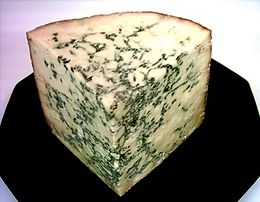现在怀念臭豆腐,多半是洒点红椒丝清蒸蒸,乐胃的家常菜。外面卖的油炸臭豆腐火候难得掌握好,炸太干了味道全失。还有上次在南浔吃到的臭豆腐炒河虾,隔着遥远的时空想起来好象又不那么咸了,只剩下鲜美的回忆
Let Them Eat Cheese
http://news.bbc.co.uk/1/hi/magazine/8199281.stm
There's nothing more alien to the Chinese palate than blue Stilton cheese. So can it and other European foods find a place in the culinary landscape of a changing China?
"This is our new product," Cinderella shouted to me over the tinny techno music. "It is called Stilton blue cheese. It is from England and its net weight is 200g."

It was a strange setting in which to see Stilton, aged using mould spores and ordinarily associated with pastoral English countryside. But here it was on a food stand in Shanghai, promoted by girls in pink nurses uniforms dancing around it and sales assistant Cinderella offering it to curious Chinese families on a day out.
The SIAL food show took place in a complex of steel and glass halls, with food stands from all over the world. Britain and other European countries had a strong showing with cheese, French wine, Scotch whisky and Belgian chocolates all now fighting a serious battle for the Chinese stomach.
The food marketers are here because they hope the Chinese middle class still has some disposable income to spend, while the rest of the world tightens its belt
But will newly wealthy Chinese people actually spend on these foreign foods? Cinderella wrinkled her nose at the odour from the mould spores that turn the Stilton cheese a fungal shade of blue.
"I cannot accept the smell," the 20-year old says in sheepish broken English.
"I think maybe Asian people don't like it because it has a big smell."
Stilton is an extreme example, but in fact many European products are very alien to Chinese tastes.
After more than 3,000 years of its own high dining, China has seen everything from cockroach to eel on the menu. But it's only in recent decades that milk or dairy products have been consumed in significant numbers, and many in the population remain lactose intolerant.
On top of that, European fine foods have plenty of local competition. China may have no indigenous whisky, cappuccino or blue cheese, but it has a plethora of white spirits, a rich legacy of traditional tea and its own soya-based "stinky" tofu - which resembles Stilton with its blue veins and effervescent odour.

These products are much more familiar and much less costly than their European equivalents. Stinky tofu, for example, comes relatively cheap in market stalls around Shanghai but 200g of Stilton costs 100 RMB, or 9 GBP.
The European strategy to overcome this is to emphasise the history and tradition behind products like Stilton cheese, Scotch whisky or French wine.

